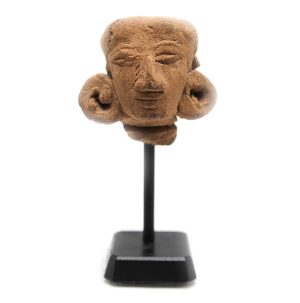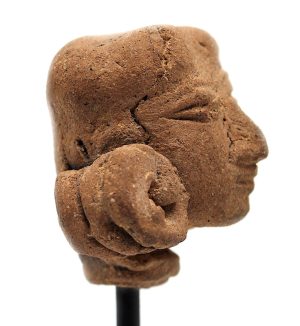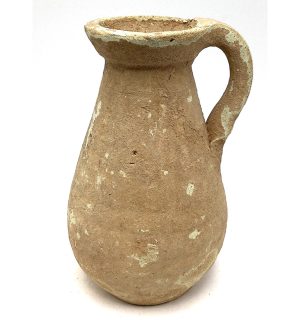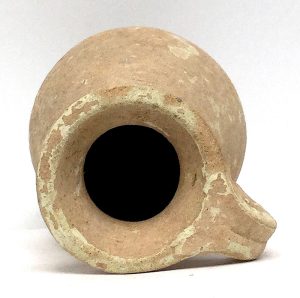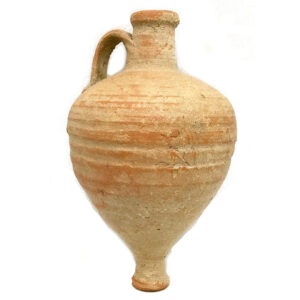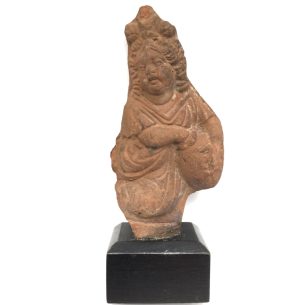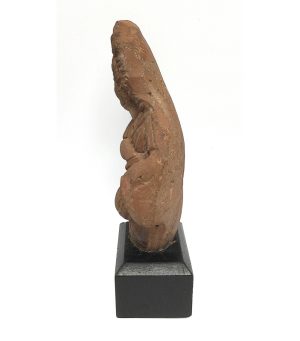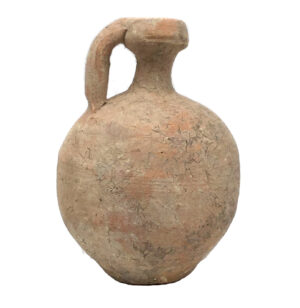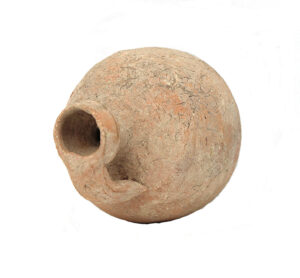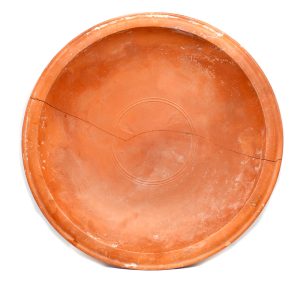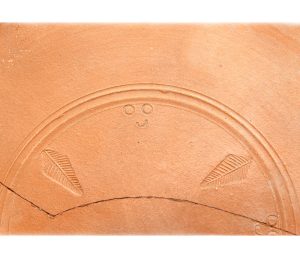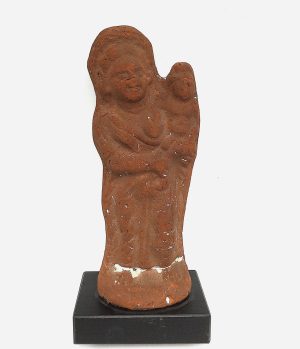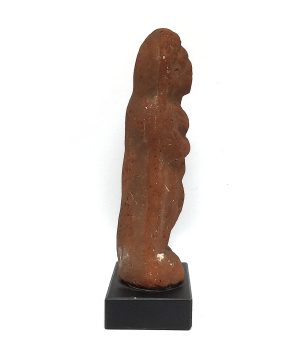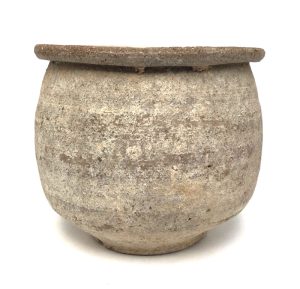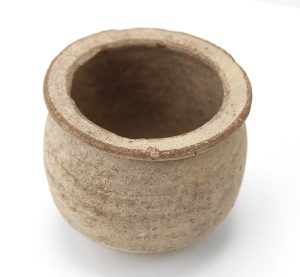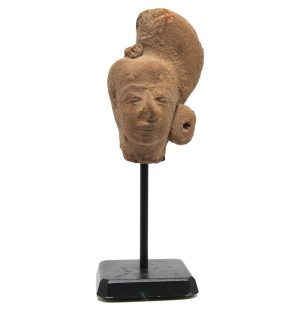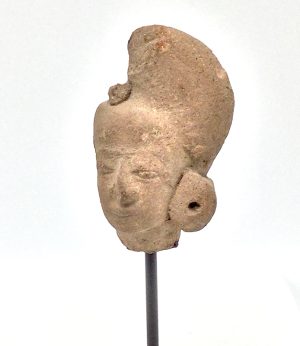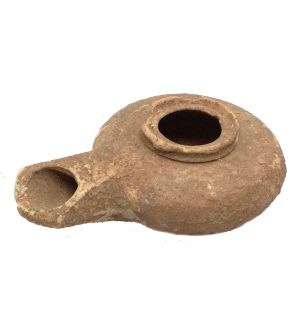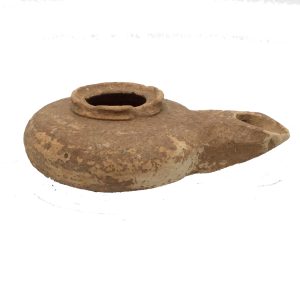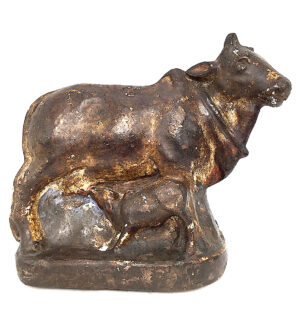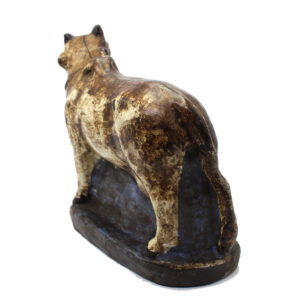Showing 1–12 of 15 results
-


$195.00
Ht: 2.75” W: 1.375” D:1.125” | FREE SHIPPING WITHIN CONTIMENTAL U.S.!
This terracotta head was crafted during the Majapahit Empire in Java and was either part of a bas-relief frieze or made as a freestanding figurine. Most figures found are small decapitated heads with no bodies, and it is very rare to find a complete figure with a naturalistic facial expression. As with many heads, this one displays Javanese facial features, hairstyles and ear ornamentation typical of the period. It has a naturalistic facial expression and wears large round coiled earrings, possibly suggesting it represented someone of the upper classes. It is in very good condition given its age and use and is mounted on a metal stand. This item pairs with Majapahit Miniature Terracotta 1138.
-
Sale!


$275.00 Original price was: $275.00.$225.00Current price is: $225.00.
H: 4.5” W: 3” D: 2.75” | FREE SHIPPING WITHIN CONTINENTAL U.S. !
Small wine jugs were made in the Roman North Africa territory called Africa Proconsulares and exported throughout the empire. Made and decorated with ribbing and a single handle on a potters wheel it was fired in a kiln. Simple and unadorned functional objects called coarse wears were made everyday use and to make offerings to deities using inexpensive long-lasting materials. Very good example of pouring vessels from ancient history throughout the Roman Empire.
-
Sale!


$425.00 Original price was: $425.00.$325.00Current price is: $325.00.
H: 5.75” W: 3.375” | FREE SHIPPING WITHIN CONTINENTAL U.S.!
An amphora is Greek jar with a single or double handles made in a variety of sizes and copied by all ancient Mediterranean trading nations. This amphoriskos, literally a “small amphora,” has a stunning profile and one handle but is top heavy and cannot stand without support. It dates from the time of the Holy Land during the first Jewish Biblical Period in Judea circa the 8th to 6th century BCE, a ancient time from which few pieces survive intact.
-


$395.00
Ht: 6.5” W: 2.625” D: 1.75” | FREE SHIPPING WITHIN CONTINENTAL U.S.!
This ancient figurine is Harpocrates the Greek god of silence and secrets holding a jar made for a home shrine. He probably represents a royal and temple cult, as he wears a double crown symbolizing both Upper and Lower Egypt and his royal emblem signifies his association with the reigning Egyptian king, who was considered a manifestation of the Egyptian god Horus. Missing part of his right side when excavated, and no with no repairs this is a true slice of history. It pairs well with #1845 Ancient Pottery Figurine of Child Nurturer Goddess.
-
Sale!


$395.00 Original price was: $395.00.$325.00Current price is: $325.00.
H: 4” Dia: 2.75″ | FREE SHIPPING WITHIN CONTINENTAL U.S.!
This pottery Judean perfume juglet was made during the Biblical Period in the Holy Land used to hold perfume or other costly items. With a handle and thick lip, and upper body tapering inward to a narrow neck it was deigned for ease of use and to conserve its contents. Covered with slip to lessen leakage and improve appearance, juglets were used throughout the Roman Empire. This uncleaned authentic vessel is good condition with no repairs, aged patina, surface incrustation and mineral deposits, hairline cracks, and minor discoloration.
-
Sale!


$485.00 Original price was: $485.00.$365.00Current price is: $365.00.
H: 2.25” Dia: 14.5″ |Free shipping in Continental US!
Created in the Roman North Africa platters like this were distributed throughout the Roman Empire. Known as s ARS (African Red Slip) it is decorated with circular rings with perfect ridges made using a pottery wheel. This ancient serving plate is remarkable for its survival, size, stamped designs and graceful simplicity. Found in two pieces, the breaks were clean and glued together. Platters of this size are rare and are usually in multiple broken pieces with significant losses.
-


$595.00
This ancient pottery lekanis is from Apulia in Magna Graecia, the Roman name for the South Italy coastal area colonized by the Greeks in the 6th century B.C.E. Greek settlers arrived with their Hellenic culture intact and had much influence on Italian civilization. A lekanis was a highly decorated low shallow bowl with close-fitting top…
-


$395.00
Ht: 6.75” W: 3” D: 2” | FREE SHIPPING WITHIN CONTINENTAL U.S.!
This Roman Egyptian figurine from Alexandria of a woman holding a young child is a Kourotrophos, a class goddess figures holding infants or children. Referred to as “child nurturers”, these were revered deities, cult figures and mortals who were also fertility symbols and protectors of the young. Made from a bivalve mold, this terracotta figurine was probably placed on a home altar for protection. Mother and child figures like this are universal and appear in cultures throughout the world. It pairs well with #1844 Ancient Harpocrates Figurine.
-
Sale!


$325.00 Original price was: $325.00.$235.00Current price is: $235.00.
H: 2.675” DIA: 3” | FREE SHIPPING WITHIN CONTINENTAL U.S.!
This simple ancient small earthenware bowl was made in Africa Proconsularis, the Roman North Africa pottery center and distributed throughout the Roman Empire. With no handle, this beaker is beautiful in its simplicity resting on a short foot, a body that curves up and rises to meet a neck and is topped with an everted rim to lessen spillage Made for daily use, this Roman coarse wear has a wide mouth for easy drinking and a rim with light terracotta red and its crème slip with an exquisite shape.
-


$195.00
Ht: 4” W: 1.5” D: 1.75”|FREE SHIPPING WITHIN CONTINENTAL U.S.!
This terracotta head was crafted during the Majapahit Empire in Java and was either part of a Hindu bas-relief frieze or made as a freestanding figurine. Most figures found are small decapitated heads with no bodies, and it is very rare to find a complete figure with a naturalistic facial expression. As with many heads, this one displays Javanese facial features, hairstyles and ear ornamentation typical of the period. It has a naturalistic facial expression and wears large round coiled earrings, possibly suggesting it represented someone of the upper classes. It is in very good condition given its age and use and is mounted on a metal stand. This items pairs with Majapahit Terracotta Head 1137.
-


$155.00
Although most famous for Christian burials, people of all religions were interred in the catacombs due to a shortage of land and demand for burial space after a switch from cremations to underground burials in the 2nd century A.D. Roman made closed earthenware terracotta lamps became the dominant oil lamp style in the Roman world…
-


$105.00
The cow in Hinduism represents divine goodness and generosity, is venerated, protected and sanctified in India and is associated with Hindu deities such as Shiva whose mount (vahana) is the bull Nandi and with some goddesses because of their beneficent maternal traits. Earthenware terracotta pottery has played a significant role in the cultural, religious and…
End of content
End of content

